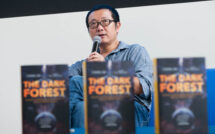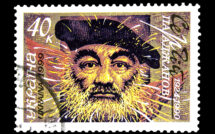
Exploring the New Middle Ages: Japanese Intellectual Discourses and the Eurasian Intersection

This is part of our special feature, Thinking Eurasia Now.
This paper explores how Japanese intellectuals have discussed the notion of the “New Middle Ages,” foregrounding the trans-regional, inter-disciplinary implication of the theme of Eurasia as it derives from debates implicating the connection between Europe and Asia, which I refer to as “the Eurasian intersection.” While the study of this intersection delves into the question of modernity, Japanese intellectuals’ discussions of the New Middle Ages has also consisted of an anti-modern vision. The paper also highlights how the recently developed Russian (neo-)Eurasianist ideology, which is tied to an anti-modern, anti-Western vision, is connected to Japanese discourses on the New Middle Ages.
Modern thinkers have developed the notion of the “New Middle Ages” by reflecting on the social system and order of the European Middle Ages in relation to contemporary social issues and crises. The earliest use of the term is credited to the Russian philosopher Nikolai Berdyaev, who wrote about it in the early 1920s. After WWI, when the critique of Western modernity became a popular intellectual current, he used the concept to envision a society that reclaimed a connection to medieval spiritual aspects as an alternative to modern society (Berdyaev 1933). In Berdyaev’s view, the modern history that started with the European Renaissance is characterized by the “separation of man from God” (Berdyaev 1933, 93), which weakened the spiritual life of human beings and popularized individualism, causing the atomization of society. For him, socialism is only “the reverse side” of this individualism, i.e., the result of disintegration, and socialism and individualism are both opposed to “an organic conception of the world” (50). Berdyaev regarded his time as a transitional period between modern times and the New Middle Ages. While acknowledging that the Middle Ages should not be romanticized, he highlighted the vital significance of God during that period.
Since the 1970s, the concept of “New Middle Ages” has become a popular tool in the theory of international relations. Hedley Bull (1977), a renowned scholar in the field, used the idea of new medievalism to describe the erosion of national sovereignty in a globalized world. Since then, scholars have further used the concept to analyze emerging global systems.[i] Moreover, the discussion surrounding the New Middle Ages has extended beyond Europe and resonated globally, for example in Japan, where the concept (atarashii chūsei) gained popularity among intellectuals after the end of the Cold War, drawing a variety of responses. Their discourse is introduced here as it played out in post-Cold War Japan, and various implications are explored. In particular, this study reveals that the question of modernity deeply conditioned the discourse on the New Middle Ages in Japan at that time.
The revival of this historical epoch contributed to creating a significant Eurasian intersection, whereby post-Cold War Asia (here through the experience of Japan) and the world were explored through an understanding of the European past. Debates on the New Middle Ages in Japan have also been historically linked to the notion of Eurasia as conceptualized by Russian expansionistic ideologists, i.e., as an alternative regional order. This paper revisits the history of the concept of New Middle Ages in Japan and shows that it emerged in the context of the Japanese empire’s attempt to establish indeed a new order in Asia.
Post-cold war world system at the “end of history”
After the Cold War ended, the concept of New Middle Ages gained widespread attention in Japan, in particular because of a 1996 bookwritten by Japanese political scientist Tanaka Akihiko —The New Middle Ages: The World System in the 21st Century—which was awarded the prestigious Suntory Prize for Social Sciences and Humanities. As the title indicates, Tanaka—a scholar of international politics—attempted to predict the incoming world system at a time in which the collapse of socialist regimes hinted at a major shift in the world order. Tanaka envisioned the emergence of a new world system and used the idea of the “New Middle Ages” to explain the changes taking place in the post-Cold War world and make sense of the status of Japan in this new system. His work evidences the importance of the Eurasian intersection as a modality, as Japan made recourse to European history to shape a new vision of its society in the post-Cold War world.
For Tanaka (1996), the Middle Ages encompassed “a different type of world system, which prevailed prior to the world that came into existence in Europe in or around the sixteenth century and was later called the ‘modern world system’” (169, translation by author). Twenty years after Bull’s work was first published, Tanaka agreed with his pioneering conceptualization of the “new” Middle Ages. However, Tanaka attempted to overcome Bull’s conclusion that the world system was not sufficiently developed to replace the state-centered international system in place at the time and established the characteristics of the medieval world system. First, Tanaka emphasized the pluralistic nature of the medieval world. In Tanaka’s view, unlike the modern world system in which sovereign states established overwhelming dominance, the European Middle Ages were distinguished by the existence of multiple governing actors such as the emperor, the pope, kings, bishops, counts, earls, and knights, who enjoyed considerable autonomy. He also referred to the important role of autonomous cities, leagues, monasteries, military and religious orders, and universities. Moreover, these actors were linked through “convoluted relationships” (170). For example, the medieval feudal system entailed a series of overlapping loyalties. The relationship between territory and political authority was fluid, and the distinction between domestic and foreign matters was not as clear as it would become in the modern world. Second, Tanaka highlighted ideological uniformity. In particular, no ideology competed with Christian universalism—under the authority of the Church of Rome— during the European Middle Ages. Under this ideological system, the idea of sovereign equality among states did not exist, and the theory of just war played a significant role, in contrast to the separation of war from moral and religious motives, which would characterize the modern world. Tanaka found similarities between the medieval and post-Cold War worlds, based on his understanding of the European Middle Ages. For example, he observed the increasing importance of non-state actors such as transnational corporations and non-governmental organizations, as the emergence of the multiplicity of actors, while indicating that liberal democracy had become the single dominant ideology after the decline of Marxism-Leninism’s influence. Echoing Francis Fukuyama, who identified the triumph of liberal democracy at the end of the Cold War, Tanaka envisioned the end of ideological conflict in the post-Cold War world.
Tanaka thus explained the emergence of a new world system similar to the European Middle Ages and reminded readers—mainly Japanese—to think about the role of Japan in this new setting. However, he did not presuppose the simultaneous formation of a new medieval system globally. Accounting for the stability and maturity of liberal democracy and the market economy, Tanaka divided the world’s nations into three spheres. In his view, the new medieval system is part of the first sphere (the “neo-medieval sphere”), which includes Western European and North American countries, as well as Japan, Israel, Australia, and New Zealand. Many Asian countries belong to the second sphere (the “modern sphere”); the third sphere, which he calls “chaotic,” mainly consists of African countries.
Based on this classification, although his book discusses the system of postmodernity, Tanaka developed a framework that resembles the conventional view of the modern world. For example, in an earlier book, The Outline of the Theory of Civilization (1875), the leading Japanese enlightenment thinker Fukuzawa Yukichi offered a well-known perspective on Japanese modernization, dividing the world into three levels: Europe and the US at the top, Asia second, and Africa at the bottom (Fukuzawa 2009 [1875]). Within this framework, Fukuzawa envisioned the modernization of Japanese society in the nineteenth century through a narrative that omitted the relationship—sometimes violent and exploitative—between different parts of the world. Tanaka’s categorization of world nations into three spheres echoed Fukuzawa’s categorization into three levels. Although Tanaka’s work did not overtly claim that the transition of a nation to the neo-medieval sphere should represent a normative path, his vision of the post-Cold War world showed that new medievalism could retain the core structure of the conventional view of modernity.
Global capital and its mode of power
Tanaka’s work was not the only response to the concept of the New Middle Ages in post-Cold War Japan. A decade after his book was published, another book took up the concept. The Beginning of the “New Middle Ages” and Japan (2008), by Japanese critic Ōkubo Kazushi, offered another perspective. Ōkubo’s book also explores the Eurasian intersection by examining the European Middle Ages to reflect on the problem of Japanese modernity and contemporary situation. For him, as for many, the end of the Cold War in the late 1980s was a historical turning point. However, instead of the triumph of liberal democracy as the end of history, what concerned him was the global integration of capital and labor markets, which shook the system of modern nation-state and national economies. For Ōkubo, the collapse of socialist regimes was also an effect of ongoing globalization, and the era that started after the Cold War was the “century of globalization” (8).
Relying on the analysis of Japanese economist Mizuno Kazuo, Ōkubo explained that what drives globalization is the “counter-revolution of capital” (14-15). During the twentieth century, socialist regimes constituted an important part of the global order, and the Keynesian social welfare system, as a reaction to it, led to increases in public investments and real wages. A major concern for capitalists was how to increase their profits while keeping wages low against the tide of social welfare. However, the collapse of socialism offered owners of capital the chance to increase their profit rate through the global integration of markets, for example because of the expansion of financial operations and the availability of cheap labor. In other words, Ōkubo contended that despite changes in social structures, the problem plaguing the capitalist economy persisted in the post-Cold War system.
Therefore, Ōkubo incorporated the concept of the New Middle Ages into his perspective, relying mainly on Bull’s theory while also recognizing Tanaka’s work. Ōkubo focused on five characteristics of the New Middle Ages that had been articulated by Bull. These include regional integration, disintegration within nation-states, the privatization of international violence (i.e., war), the rise of transnational organizations, and the global integration of technology. Bull had already envisioned these characteristics in the 1970s, but Ōkubo showed how they were actually being realized during his own era, highlighting the disintegration of the close tie between capital and the state. As a result, he stated that the horizontal economic disparity that existed between the inside and outside of national societies had been displaced into a vertical and stratified economic disparity transcending national boundaries; moreover, the political, economic, social, and cultural subjects and units became pluralized and multilayered.
To further elucidate his perspective, Ōkubo referred to Antonio Negri and Michael Hardt’s Empire (2000). In particular, Ōkubo evaluated their analysis of the mode of power in the post-Cold War world order as providing useful insights to understand the conditions of the New Middle Ages. Empire traces the transformation of the modern social system as the transition from a disciplinary society to a society of control and emphasizes the function of biopower, which works immanently in social and productive relationships and contributes to the regulation and subordination of life. The functions of biopower as a means of crossing national borders go hand in hand with the globalization of capital. According to Ōkubo, this model duly grasps the problem of the situation of the New Middle Ages. However, Ōkubo did not completely agree with the way Negri and Hardt articulated the contemporary situation as a conflict between the emerging ruling power as empire and its counterforce as multitude. He argued that Negri and Hardt’s idea of multitude (ununified social subjects) still gave an impression of multiplicity at a single-layered level and understated the multilayered reality of the new world order. Instead, Ōkubo emphasized the importance of the autonomy of smaller-scale societies and localities. Therefore, while he criticized contemporary Japanese nationalism, he encouraged Japanese people to develop autonomous and small-scale forms of associations such as nonprofit organizations and co-ops. Thus, through the Eurasian intersection, Ōkubo reflected on the question of modernity and, relying on Marxist analysis, he envisioned the way Japanese society should move forward.
In contrast to Tanaka’s emphasis on the hegemony of liberal democracy, Ōkubo critically examined the post-Cold War order through the development of global capital and a new way to exercise power. Still, he shared Tanaka’s affirmative use of the idea of the New Middle Ages as a conceptual tool to approach an emerging world system. However, the idea of the New Middle Ages was used not only for liberal or Marxist analysis of a new order but also for a reactionary anti-modern discourse, signaling its resonance with recent Eurasian ideology that also incooporates an anti-modern vision.
Critique of modernity
Two years before Tanaka’s book was published, the novelist Yamaguchi Izumi (1994) had also examined the idea of the New Middle Ages in his book, The New Middle Ages are Coming!. Yamaguchi’s work also addressed the Eurasian intersection by approaching the contemporary problems in Japanese society through his reflections on European history. However, unlike Tanaka and Ōkubo, Yamaguchi refered to the idea of the New Middle Ages to criticize its reactionary implications. In particular, Yamaguchi expressed concern about the ideal of socialism being downplayed and the medieval social system being reevaluated in contemporary discourse. Yamaguchi’s work shed light on how the idea of the New Middle Ages functions in a counter-modern logic.
In his book, Yamaguchi recruited Berdyaev’s work as a prototype of the discourse on the New Middle Ages and criticized it as anti-modern because it undervalued the important ideals of equality and human rights. Yamaguchi also mentioned that Berdyaev had contested the Marxist framework. Berdyaev wrote that “Life’s center of gravity is shifted to the sphere of economics, and the sciences and the arts and all spiritual values are looked on a ‘reflex.’ Man has become an economic category” (51). Yamaguchi argued against this critique, stating instead that the Marxist perspective emerged as a “method” to address such a mechanism of alienation (Yamaguchi, 76-77).
Ōkubo too explored the historical function of the New Middle Ages in counter-modern discourses, toward which Yamaguchi had issued a warning. Ōkubo recognized that since the late eighteenth century, the Romantics’ reaction toward the Enlightenment movement, the critique of modernity, and the reevaluation of the Middle Ages had emerged repeatedly. He particularly emphasized that European intellectuals after WWI aimed to “overcome modernity.” During that period, reflecting a sense of crisis in European civilization, some European thinkers also critiqued modern humanism. For example, Ōkubo referred to Karl Barth’s The Epistle to the Romans (1919), Carl Schmitt’s Political Theology (1922), and Martin Heidegger’s Being and Time (1927) to show that representative texts of interwar European intellectual history critically engaged in modern humanism. Moreover, Ōkubo situated Berdyaev’s discussion of the New Middle Ages in the broader interwar European context. His pursuit was to draw lessons from European and Japanese medieval histories in order to explore alternative models of individualism and social relationships while taking a nuanced approach to the historical discourse on the New Middle Ages. The function of the New Middle Ages in overcoming modernity, however, is also related to a historical attempt in Japan to establish a new order in Asia. This new order resonates to a certain extent with the idea of Eurasia as adopted in contemporary Russia to build an alternative regional order based on an anti-modern, anti-Western vision.
Yamaguchi’s and Ōkubo’s works indicate that the concept of the New Middle Ages originally emerged in the context of the interwar crisis of European civilization and modern humanism. At the time, Japanese intellectuals widely shared such a critical sense of modernity. In fact, the concept of the New Middle Ages also appeared in Japanese discourse on “overcoming modernity” (kindai no chōkoku), which was the title of a famous symposium held during WWII. Articulating the mission of the Japanese Empire during the ongoing imperial war, the symposium was based on the critique of modern humanism and individualism (Calichman 2008). Suzuki Shigetaka—a Japanese specialist of European medieval history—contributed to the symposium. He was a member of the Kyoto school, a group of scholars who offered a philosophical justification for the establishment of a new regional order by Japan, which they called the “Greater East Asia Co-prosperity Sphere.” In his book, The Ideal of Historical States (Suzuki 1941), Suzuki introduced the New Middle Ages to indicate the then ongoing social and civilizational transformation taking place in Europe at the same time as the “decline of capitalism, democracy, liberalism, and humanism” (204-205). He also endorsed Berdyaev’s discussion and critique of modernity.[ii] However, he thought it was impossible and meaningless to return to a medieval society while he also admitted that modern society lacked organic human relationships and reduced individuals to atomized beings lacking spiritual unity. Therefore, he emphasized the role of religion in the medieval era to find clues to solve the problems of his own time. He was not the only scholar to critique modernity and pay attention to the preceding era; however, he wrote during the Japanese imperial expansion, so that his discourse on overcoming modernity was articulated around the limits of European modernity and the legitimization of Japan’s initiative to establish an alternative regional order against Western rule. Suzuki’s work shows that the implications of the concept of the New Middle Ages could converge with the expansionistic anti-Western narrative of local powers in the critique of modernity and help in an understanding of Eurasia as part of the contemporary anti-Western, anti-modern discourse.
A recent study points out that neomedievalism is also influential in contemporary Eurasian ideology emerging out of Russia, which has attempted to establish itself as “a self-sufficient civilization of a higher order than the West” (Khapaeva 2017)—because it offers an alternative to important values of modernity such as democracy and individualism.Thus, the New Middle Ages have recently reemerged in the discussion of an alternative Eurasian regional order and represent an important component of a modern and global intellectual discourse. Japanese intellectuals have connected Asia and Europe through a complex interlacing of modernity theories and reframed conventional historical narratives of progress. Through their diverse reactions to the New Middle Ages, they have not only shown the notion’s historical role in defining new world systems based on the Eurasian connection, but they have also indicated the political implication of the concept as the possible arrival of a reactionary order.
This paper was supported by the University Grants Committee (Hong Kong) under GRF [12602721]
Noriaki Hoshino is currently an Assistant Professor in the Department of History at Hong Kong Baptist University. He received a PhD in history from Cornell University. His research interests include modern Japanese intellectual history, cultural history, and human mobility.
[i] These historical currents were recently reflected on as the study of “neomedievalism.” See, Robinson and Clements (2009) and Lewicki (2017). Robinson and Clements find the origin of the term in the work of Umberto Eco and Hedley Bull in the 1970s. Lewicki finds its earliest use in Berdyaev’s work, but Lewicki disagrees with Berdyaev’s approach because of its escapism and reactionary nature.
[ii] Yoshimistu Yoshihiko, a Christian philosopher, also participated in the symposium, and his article for the symposium referred to Berdyaev’s New Middle Ages (Calichman, 77-91).
References
Berdyaev, Nikolai. 1933. The End of Our Time. New York: Sheed & Ward.
Bull, Hedley. 1977. The Anarchical Society: A Study of Order in World Politics. London: Macmillan.
Calichman, Richard (ed & trans). 2008. Overcoming Modernity: Cultural Identity in Wartime Japan. New York: Columbia University Press.
Fukuzawa, Yukichi. 2009. An Outline of a Theory of Civilization, translated by David Dilworth. New York: Columbia University Press.
Grzegorz Lewicki. 2017. “Return to the Future: Neomedievalism, Globalization, Cities” in Cities in the Neomedieval Era: 7-21. https://neomedievalism.files.wordpress.com/2017/07/cities-in-neomedieval-era-edited-by-greg-lewicki-neomedievalism-v1-01.pdf
Hardt, Michael and Antonio Negri. 2000. Empire. Cambridge: Harvard University Press.
Khapaeva, Dina. 2017. “Neomedievalism as a Future Society: The Case of Russia,” in The Year’s Work in Medievalism, 32.
Ōkubo, Kazushi. 2008. Atarashii chūsei no hajimari to Nihon: yūkai suru kindai to Nihon no saihakken. Tokyo: Kaden sha.
Robinson, Carol L. and Pamela Clements. 2009. “Living with Neomedievalism,” in Studies in Medievalism, 18: 55-74.
Suzuki, Shigetaka. 1941. Rekishteki kokka no rinen. Tokyo: Kōbundō shobō.
Tanaka, Akihiko. 1996. Atarashii chūsei:nijūisseiki no sekai shisutemu. Tokyo: Nihon keizaishinbun sha.
Yamaguchi, Izumi. 1994. Atarashii chūsei ga yattekita!. Tokyo: Iwanami shoten.
Published on September 12, 2023.




